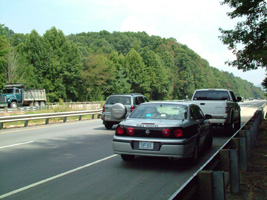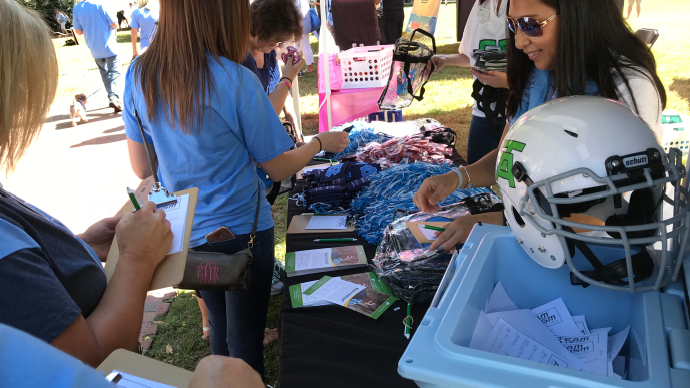
Yesterday, on our Facebook page, we posted an article from the Charlotte Observer about the expansion of the North Carolina Move Over Law which went into effect on October 1st. As a recap, the North Carolina “Move Over” Law was expanded to include utility and maintenance crews including tow trucks with amber flashing lights. For those who weren’t aware of the “Move Over” Law or for those who just want to get the full details of the law, below we have provided the full text of the law from the North Carolina Department of Transportation.
§ 20‑157. Approach of law enforcement, fire department or rescue squad vehicles or ambulances; driving over fire hose or blocking fire‑fighting equipment; parking, etc., near law enforcement, fire department, or rescue squad vehicle or ambulance.
(a) Upon the approach of any law enforcement or fire department vehicle or public or private ambulance or rescue squad emergency service vehicle giving warning signal by appropriate light and by audible bell, siren or exhaust whistle, audible under normal conditions from a distance not less than 1000 feet, the driver of every other vehicle shall immediately drive the same to a position as near as possible and parallel to the right‑hand edge or curb, clear of any intersection of streets or highways, and shall stop and remain in such position unless otherwise directed by a law enforcement or traffic officer until law enforcement or fire department vehicle or public or private ambulance or rescue squad emergency service vehicle shall have passed. Provided, however, this subsection shall not apply to vehicles traveling in the opposite direction of the vehicles herein enumerated when traveling on a four‑lane limited access highway with a median divider dividing the highway for vehicles traveling in opposite directions, and provided further that the violation of this subsection shall be negligence per se. Violation of this subsection is a Class 2 misdemeanor.
(b) It shall be unlawful for the driver of any vehicle other than one on official business to follow any fire apparatus traveling in response to a fire alarm closer than one block or to drive into or park such vehicle within one block where fire apparatus has stopped in answer to a fire alarm.
(c) Outside of the corporate limits of any city or town it shall be unlawful for the driver of any vehicle other than one on official business to follow any fire apparatus traveling in response to a fire alarm closer than 400 feet or to drive into or park such vehicle within a space of 400 feet from where fire apparatus has stopped in answer to a fire alarm.
(d) It shall be unlawful to drive a motor vehicle over a fire hose or any other equipment that is being used at a fire at any time, or to block a fire‑fighting apparatus or any other equipment from its source of supply regardless of its distance from the fire.
(e) It shall be unlawful for the driver of a vehicle, other than one on official business, to park and leave standing such vehicle within 100 feet of law enforcement or fire department vehicles, public or private ambulances, or rescue squad emergency vehicles which are engaged in the investigation of an accident or engaged in rendering assistance to victims of such accident.
(f) When an authorized emergency vehicle as described in subsection (a) of this section or any public service vehicle is parked or standing within 12 feet of a roadway and is giving a warning signal by appropriate light, the driver of every other approaching vehicle shall, as soon as it is safe and when not otherwise directed by an individual lawfully directing traffic, do one of the following:
(1) Move the vehicle into a lane that is not the lane nearest the parked or standing authorized emergency vehicle or public service vehicle and continue traveling in that lane until safely clear of the authorized emergency vehicle. This paragraph applies only if the roadway has at least two lanes for traffic proceeding in the direction of the approaching vehicle and if the approaching vehicle may change lanes safely and without interfering with any vehicular traffic.
(2) Slow the vehicle, maintaining a safe speed for traffic conditions, and operate the vehicle at a reduced speed and be prepared to stop until completely past the authorized emergency vehicle or public service vehicle. This paragraph applies only if the roadway has only one lane for traffic proceeding in the direction of the approaching vehicle or if the approaching vehicle may not change lanes safely and without interfering with any vehicular traffic.
For purposes of this section, “public service vehicle” means a vehicle that is being used to assist motorists or law enforcement officers with wrecked or disabled vehicles, or is a vehicle being used to restore electric utility service due to an unplanned event, and is operating an amber‑colored flashing light authorized by G.S. 20‑130.2. Violation of this subsection shall be negligence per se.
(g) Except as provided in subsections (a), (h), and (i) of this section, violation of this section shall be an infraction punishable by a fine of two hundred fifty dollars ($250.00).
(h) A person who violates this section and causes damage to property in the immediate area of the authorized emergency vehicle or public service vehicle in excess of five hundred dollars ($500.00), or causes injury to a law enforcement officer, a firefighter, an emergency vehicle operator, an Incident Management Assistance Patrol member, a public service vehicle operator, or any other emergency response person in the immediate area of the authorized emergency vehicle or public service vehicle is guilty of a Class 1 misdemeanor.
(i) A person who violates this section and causes serious injury or death to a law enforcement officer, a firefighter, an emergency vehicle operator, an Incident Management Assistance Patrol member, a public service vehicle operator, or any other emergency response person in the immediate area of the authorized emergency vehicle or public service vehicle is guilty of a Class I felony. The Division may suspend, for up to six months, the drivers license of any person convicted under this subsection. If the Division suspends a person’s license under this subsection, a judge may allow the licensee a limited driving privilege for a period not to exceed the period of suspension, provided the person’s license has not also been revoked or suspended under any other provision of law. The limited driving privilege shall be issued in the same manner and under the terms and conditions prescribed in G.S. 20‑16.1(b). (1937, c. 407, s. 119; 1955, cc. 173, 744; 1971, c. 366, ss. 1, 2; 1985, c. 764, s. 31; 1985 (Reg. Sess., 1986), c. 852, s. 17; 1993, c. 539, s. 372; 1994, Ex. Sess., c. 24, s. 14(c); 2001‑331, s. 1; 2005‑189, s. 1; 2006‑259, s. 9; 2007‑360, s. 1; 2010‑132, s. 12.)
*Photo courtesy of the North Carolina Department of Public Safety




Leave a comment